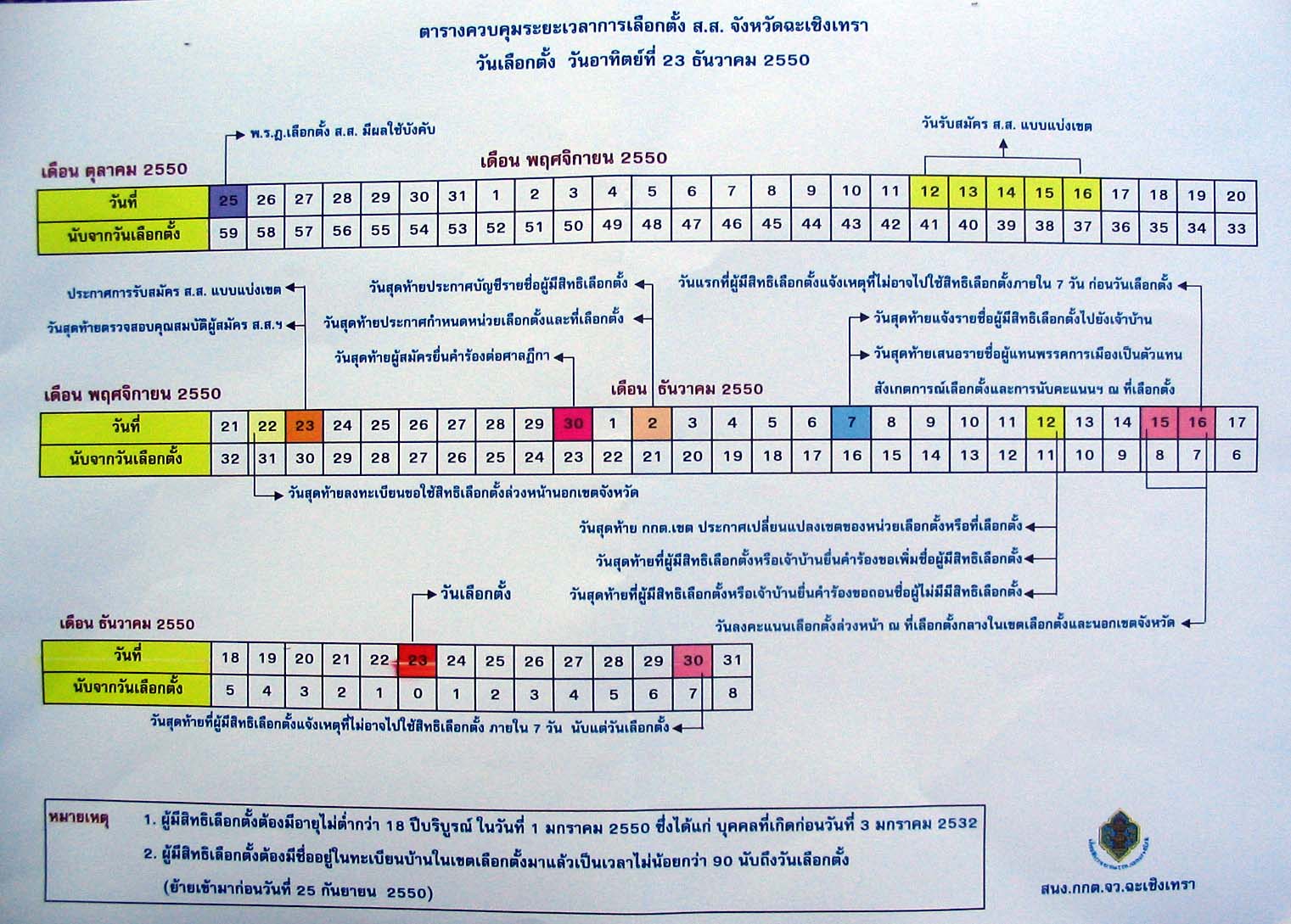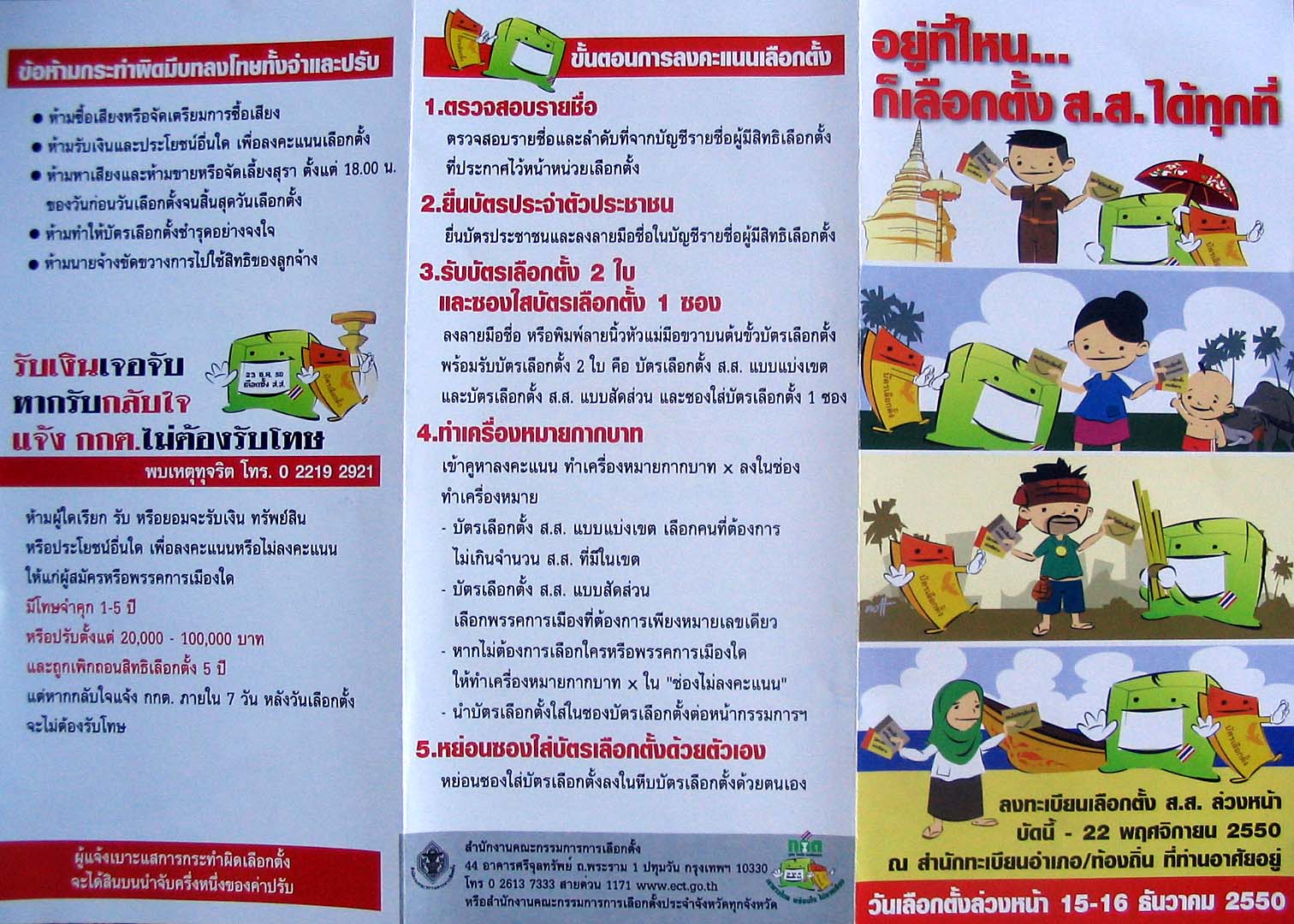The electoral calendar provides some basic data on the management of the election by the Provincial Election Commission (PEC), or rather its office, in Chachoengsao province. However, since this is a centralized structure, it applies in the other provinces as well. The electoral calendar covers the period from 59 days before the election until eight days after it. The production of charts such as the one seen in picture 1 has become a routine element of the ECT’s and the PEC’s work. They are also produced for local elections. Its purpose is expressed in the Thai-language headline: “Control table for the time period of the election of MPs in Chachoengsao province.” However, it does not cover all administrative steps necessary for managing the election.
Picture 1
October 25
The Royal Decree on the MP election comes into effect.
November 12-16
Registration of constituency candidates. The registration of candidates running in the proportional system, though it is divided into eight provincial clusters, was held in Bangkok one week earlier.
November 22
Last day for voters to register their intention to use their right in advance voting outside of the province where their formal residence is. If voters have their housing register in a province different from that they are residing in, but do not want to travel home for the election, they can vote at the advance polling station in their province of residence. However, they will have to register in order to be included in special voter rolls concerning their home provinces, while their names will be deleted from in the voter rolls of their home polling stations (article 97 of the Election Act states that such voters must register within 30 days before the election). Pictures 2 and 3 show the ECT’s leaflet advertising this possibility to the voters. Judging from past elections, few voters will make use of this opportunity, and many of those who had registered will not come and vote. The government knows this situation and thus declared December 24 a public holiday.
Picture 2
Picture 3
November 23
Last day for checking the qualifications of constituency MP candidates. Announcement of approval of constituency MP candidates. With this act, the candidacies become official.
November 30
Last day for candidates to submit their petition to the Supreme Court (in case their application had been rejected).
December 2
Last day for the announcement of the voter rolls. To enable voters to check the correctness of the rolls, they will be put on display at places such as the provincial hall, the district administrations, and near the designated polling station.
Last day for the announcement of polling units (nuai lueaktang, the geographical area, mostly village-based, comprising a number of voters) and polling stations (thi lueaktang, the physical place were the voters will cast their ballots, for example, schools, temples, or tents).
December 7
Last day for informing household heads about who had the right to vote in his or her household. The ECT will send lists with the voters in any given household, based on the housing register, to every household in the country. Information material on the election and political parties might also be included.
Last day for the political parties to nominate representatives to observe the voting and vote counting in the polling stations.
December 12
Last day for the constituency committees to announce changes concerning the areas of a polling units or the locations of polling stations. The immediate management of electoral details in the constituencies does not rest with the PECs and its offices, but with PEC-proposed and ECT-appointed constituency committees and its directors. Thus, the election administration comprises five levels: ECT (and its office), PEC (and its office), constituency, district, polling station. The five members of the PECs function as a temporary board, not as people involved in day-to-day management. This is done by the PEC office under the guidance of its director. In Chachoengsao, the office comprises the director, three staff members in the general administration section, three in the election section, two each in the political party and public participation sections, and four in the investigation section, altogether 15 people.
Last day for voters or household heads to ask for the addition of names of voters or for the withdrawal of names.
December 15 and 16
Advance voting at the central polling stations of the constituencies (called thilueaktang klang nai khet lueaktang), and voting at the provinces’ central polling stations for people who had registered to cast their ballots outside of their provinces (this station is called thilueaktang klang nok khet changwat). The first opportunity is designed for voters who have documented valid reasons preventing them to go to their polling station on election day, be it that they have to serve on a polling station committee, or that they must travel due to their jobs. These voters do not have to register in advance, but turn up at the advance polling station with a document confirming the necessity of their absence. After their request will have been approved, they will proceed to the section were the voter rolls from all polling stations in the constituency are kept. Their names will be crossed out of the original list.
December 16
First day that voters can inform the election commission that they will not be able to cast their ballot on election day (seven days before the election). Voters who do not submit this information, or whose reasons are deemed insufficient, will lose a number of rights.
December 23
Election day. Polling stations are open from 08:00 to 15.00. In the election of 2005, this limited time, coupled with a high turnout, had put a number of polling stations into trouble.
December 30
Last day that voters can inform the election commission that they could cast their ballot on election day (seven days after the election).
 Facebook
Facebook  Twitter
Twitter  Soundcloud
Soundcloud  Youtube
Youtube  Rss
Rss 

